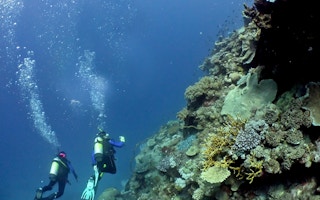The world’s first continent-wide survey of reef sea life has found big fish gone around much of the Australian coastline.
A year-long circumnavigation of Australia ended in Hobart on Wednesday with a trove of data from 700 coral and rock reef sites surveyed by volunteer divers for the Reef Life Survey Foundation.
Program co-founder Graham Edgar, of the University of Tasmania, said the first comprehensive study of any continent’s reef systems found biodiversity losses, compared to earlier local counts.
”Virtually all of our coastline has had all the larger predatory organisms reduced - from the big fishes to the lobsters,” said Professor Edgar, from the UTAS Institute of Marine and Antarctic Studies.
”It’s not just over-fishing, it’s the spread of invasive species and problems such as pollution when you get near metropolitan areas.”
His 14-metre catamaran Reef Dragon served as dive platform on a 12,000 nautical mile circumnavigation while 75 trained divers examined the life on reefs up to 400 nautical miles offshore. The odyssey took the divers from the pitch dark waters of Port Davey in south-west Tasmania to spectacular Osprey Reef, a sheer-walled coral atoll off far north Queensland.
“
It’s not just over-fishing, it’s the spread of invasive species and problems such as pollution when you get near metropolitan areas
Professor Graham Edgar, UTAS Institute of Marine and Antarctic Studies
Pioneering collections of biological information were made in the Coral Sea and off the North-West Shelf on the way down the West Australian coast and back to Tasmania, where Reef Dragon docked in a Derwent River marina.
Professor Edgar said the final report card was ”a mixed bag”.
”Some of the reefs are doing really well, particularly off the North-West Shelf where there are good numbers of large fish,” he said. ”Elsewhere coral reefs are seriously degraded by bleaching. There have been some massive changes out of sight in the marine environment.”
Data collected on this, and other surveys, is making its way into what the New York Times said in an editorial this week was eye-opening work by Professor Edgar and other Tasmanian researchers.
According to a study published this month in Nature, the best protection for marine life comes in reserves that are likely to be ”no-take”, well-enforced, more than 10 years old, more than 100 square kilometres, and isolated by deep water or sand.
The New York Times said: ”Marine-protected areas are clearly a positive trend, a reflection of the growing awareness of governments across the globe that the oceans and their bounty are not limitless or indestructible.”
Australia’s 3.1 million square kilometre system of marine reserves is in doubt after the federal government’s decision to scrap most of the network’s management plans and no-take zones. An expert scientific panel will examine the science behind the reserves, and advisory panels are to be chosen to improve stakeholder consultation.
Environment Minister Greg Hunt is yet to announce membership of the panels.










